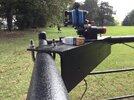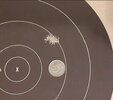Dr T
Member
1. I have seen this in several places. However, to get a resonate tone (or lack thereof), your steadying hand SHOULD NOT be on the barrel.. If it is on the barrel, it will dampen vibration. This may be of some slight interest: https://www.yamaha.com/en/musical_instrument_guide/marimba/mechanism/mechanism002.htmlYou can determine the sweet spot by taking a wooden dowel or rubber mallet and knocking down the barrel. You eventually will hit the spot that does not vibrate or make noise. You can do this with the scope on. Some people put a piece of tape to mark it and then they ensure they rest it exactly in the middle of what is supporting the barrel.
2. On the recoil: Left over from my scuba diving days, I have a neoprene weight belt and a bunch of bags each filled with about 2 lbs of #6 shot. When working with anything of heavy recoil (like a 375 H&H or 35 Whelen with 250 gr loads) I wrap it around the buttstock just behind the pistol grip. If the comb on the stock is a bit low, I may move it back a bit to give me a bit of a cheek rest. It does a nice job of taming the recoil (and fitting the eye alignment tends to help with the groups).
3. I submit that shooting multiple 3 shot groups isn't so bad mathematically. If you take the group sizes. Say you have 30 such groups (only 90 rounds), break them into 10 sets of 3 groups, and take the averages size of each of these sets, you will have 10 observations that follow the Normal (Gaussian) distribution (Central Limit Theorem). With this rifle, however, you may want to make sure the technique I described in Item 2 works.
Last edited:




